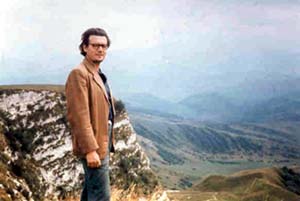
| Foreword | Introduction | One | Two | Three | Four | Five | Six | Seven | Bibliography |
 |
- I N T R O D U C T I O N -
| |
This is my third major publication in English dealing with the problems of a new discipline — hominology.
The first two, In The Footsteps of the Russian Snowman (1996) and America's BIGFOOT: Fact, Not
Fiction* (1997), present and discuss certain evidence for the existence of relict hominoids
(actually, hominids) in Eurasia and North America. The books also give the reader an idea why
this evidence has been ignored or rejected by the scientific establishment for so long. The
science of primatology, as foreseen by Boris Porshnev, is on the verge of a revolutionary
change, spurred by the emergence of a new paradigm concerning the origin of modern man — Homo
sapiens. Within the old paradigm, primatology, anthropology, and paleoanthropology are simply
conceptually impotent to deal with the phenomenon of relict hominids. Thus there appeared a
divide and conflict in science between those who recognize the reality of this phenomenon and those who reject it.
|
This work is about a conflict and split among Bigfoot researchers themselves, a source of their weakness for decades. It is a conflict over the eternal problem of ends and means — how to prove the existence of Bigfoot in the face of relentless opposition from the scientific community. Here is the opinion of John Green: "Science will keep its eyes tightly shut until someone produces a body, or part of one, and the more quickly it is done the better. The successful hunter should find it very profitable as well." (The Sasquatch File, 1973, p. 71.) Grover Krantz's attitude is described in the press as follows: "He is one of the most vocal proponents of killing a Sasquatch in order to prove they exist. 'I want to rub a few faces in the corpse,' he says. His advice is to shoot it, cut off an arm or a leg or anything you can carry and get the hell out." (Human Behavior, September 1978, p. 20.) 
Dmitri Bayanov surveying almasti country in the hills of Kabarda, North Caucasus.
In the mid 1970ís, I initiated a "great debate" by correspondence among several hominologists
on the "to kill or to film" question — in which Green and I were the main adversaries. The
controversy culminated in my rebuttal to Green, "Why It Is Not Right To Kill A Gentle Giant",
published in Pursuit, Fall 1980. During the 1980s I argued and clashed with Grover Krantz
over the issue. He published his pro-kill views and calls in the article "Research on Unknown
Hominoids in North America" (1984) and in his book Big Footprints: A Scientific Inquiry into
the Reality of Sasquatch* (1992). My counter-arguments are either unpublished or printed in
obscure publications which is reason enough to bring them to light here. The airing is needed
not just for argument's sake but because the issue is of great humanistic significance.
* Available from Amazon.com
|
| Foreword | Introduction | One | Two | Three | Four | Five | Six | Seven | Bibliography |